Fractals – it sounds like something that happens when you break your arm, doesn’t it? The word actually derives from the same Latin precursor as fracture, frāctus – something ‘broken’. And truthfully, fractals will probably break your mind if you think about it for too long….. (speaking from experience). As a result, I’m going to give you lots of pictures, as words do not do these amazing numbers justice. I will also stay away from any of the more complex mathematics, as they are difficult for even talented mathematicians.
A simplified explanation of fractals is that of ‘self-similarity at all scales’. If that seems a bit weird, just imagine Russian nesting dolls, or the classic ‘infinity mirror’. At some point the image becomes too small for us to detect in a mirror, but mathematically, these replications can continue infinitely. In fractals, the structure itself may not necessarily ‘look’ the same at all scales, but contains the same patterns/shapes over and over again. And the self-replicating pattern is infinitely zoomable – in or out. What you see simply depends on where you are zoomed into. A crazy, never-ending, infinite scale of numbers, images, and patterns!
In the Western lineage of knowledge, the mathematical concept dates back to explorations in the 17th century by Gottfried Leibniz (b.1646, d.1716), a German mathematician who began to think about ‘recursive self-similarity’ – a pattern that repeats based upon earlier rules. He lamented, however, that geometry (then) had no explanation for this phenomena. This unusual idea and the ‘mathematical monsters’ it implied was received with much resistance, and shelved for almost a century.
In the 19th century, several other mathematicians returned to the idea and began exploring it – including Georg Cantor, a Russian born, German mathematician (b. 1845, d.1918). He thought about what it meant to break down a line into two, then breaking those lines into two, and those lines into two, and so on, as shown below.
Mathematically, this exercise can continue infinitely, with each line having an infinite amount of points (while also increasing the length of the ruler to infinity). The thing that was revelatory to Cantor, was that once you broke the line down into infinite points, the sum of the infinite points was larger than the singular infinity of the line. This means that there was something greater than infinity! This was classified as “transfinite numbers” (transfinite was used to avoid the complications of explaining to people how to divide infinity), and all of these ideas are now central to ‘set theory‘ – the study of infinities. But back then, discussions of infinity were relegated to philosophy, so being able to mathematically work with infinity as a concept akin to a finite number was pretty much blasphemous.
A Swedish mathematician, Helge Von Koch (b.1870, d. 1924), came along shortly after and performed this mathematical experiment in the reverse manner – he added segmented lines to themselves infinitely. This resulted in the beautiful patterns now known as the Koch Curves. This idea was still difficult to grasp, as it called into question all of reality (how can you have an infinite of infinity? Cantor believed that was were you could find God), and was shelved once again (though many mathematicians continued to come up with graphs and shapes that reflected fractal behaviours and patterns).
For many decades, this idea lay relatively dormant in Western academic circles. Then in the 1970’s a Polish-born, French mathematician named Benoit Mandelbrot (b.1924, d.2010) had the brilliant idea of using the now-invented electronic computer to graph and display these scalable, mathematical relationships. Mandelbrot worked at IBM for 35 years, and was a cutting-edge scientist in many fields, but focused primarily on numbers.
Mandelbrot had often pondered how one could measure the ‘roughness’ found so commonly in nature in elements like coastlines or mountain ranges, and come up with an accurate measurement. In doing so, he discovered you can – and the answer is not a clear shape or line, but infinity. As he said “Clouds are not spheres, mountains are not cones, coastlines are not circles, and bark is not smooth, nor does lightning travel in a straight line.” A classic example is the “Coastline Paradox”, first observed along the English coastline by Lewis Fry Richardson. According to Euclidean geometry, the shortest distance between two points is a straight line, and this line only has one measurable length. So say you have a ruler, and you want to measure the length of a (obviously not-straight) coastline. As you measure with your ruler at one scale, you realize that this is not a completely accurate measurement, and that you can actually get a smaller ruler to measure the coastline at a finer resolution. However, if you used a smaller and smaller ruler, you would get a longer and longer coastline length, and it never actually ends. What is your smallest measurement? A metre? A grain of sand? There is no “end point” at which you can say you have measured the coastline to its most precise length – thus the paradox.
Building upon the work of Cantor, Koch, and others, Mandelbrot coined the term ‘fractal’ in 1975, in his seminal work The Fractal Geometry of Nature (side note: my partner has a copy of it, and whenever I pick it up, I’m absolutely mindblown at two things: 1) How little I know, and 2) How hilarious Mandelbrot is, in that self-deprecating, wry professor way). In this text, he builds upon his early publication Fractals: Form, Chance, and Dimension, and explored how these self-similar patterns are found everywhere in nature. As a result of his insight and study of fractals with the use of computer software, he is considered the Father of Fractals.
Nowadays, fractals are well documented and designed using computers (of course, not infinitely, given the limitations of time and space that we humans exist in normally). There’s also plenty of computer-generated videos of ‘fractal zooms’. For two-dimensional images, you can essentially plug a formula in, and get a fractal output. Some basic demonstrations of fractals are laid out below in the image below, which displays the fractals Gosper island, Koch snowflake, box fractal, and Sierpiński sieve:
This series below is a rather famous Mandelbrot fractal derived from the equation (z → z2 + c), taken from Julia sets. You can see, as you move “into” the zoom, the image changes, but the original ‘spider’ or ‘bug’ formation remains the same:
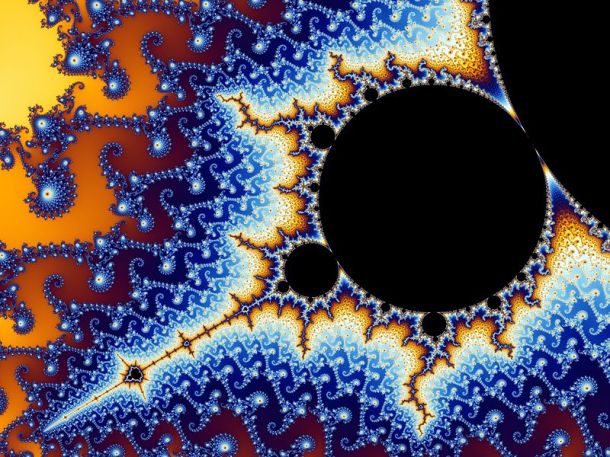
Zooming into the Mandelbrot set – you can see hints of where replication is becoming visible along the edge of the circle
But where might you have seen fractals yourself in nature? What about in a head of Romanesco broccoli/cauliflower, that was available at our local farmers market this season? Notice how the large pyramid of the cauliflower is composed of small pyramids, which in themselves are composed of smaller pyramids, and so on? (Bias alert – I love these guys).
Or how about a walk through the woods – anyone can stop at a fern and notice the unfurling patterns on the leaf and how they replicate, from the large leaf composed of smaller leaves, which are composed of smaller leaves, etc. One could also look up to the skies and see nested patterns in the clouds, or find them in the snowflake on your jacket. You could even simply take a breath – your hearbeat is a fractal! Other well-known examples of fractal patterns include lightning bolts, mountains, ammonites, drainage patterns, DNA, earthquakes, mountain goat horns, crystals, and so on. Check out this Wired article for some awesome visuals of fractals in nature. In terms of humans, you may have noticed at the beginning, I mentioned that it is a recent idea for the West. This is because fractals exist (consciously and simply intuitively) in the architecture of many African villages and art forms, and have done so for a very long time, as this fascinati ng TED talk by Ron Eglash, an ethno-mathematician reveals.
ng TED talk by Ron Eglash, an ethno-mathematician reveals.
So this nested, repeating, self-similarity pattern exists everywhere in nature. Why is it crucial for us to know about and understand it? Because the utter simplicity of it renders complex, literally infinite patterns that affect us profoundly. In the way that the binary code of 0 and 1 is responsible for all the computational coding in our lives, the fractal premise of “self-replicating patterns” is responsible for a ludicrous amount of patterns in nature, and ourselves. So understanding fractals help us understand many scientific concepts, who’s complexity had previously puzzled academics prior to this explanatory formula, things like snowflake development, bacterial growth, etc.
Moving beyond that, fractals have enormous potential in human society and technology – Google is massively successful because they were the first ones to capitalize on the properties of self-similar organization, and fractals are readily reflected in the stock market. In technology, this simple self-similarity pattern can be applied to create incredibly complex programs and devices. It can be (and is being) applied to antennas, transistors, heat exchangers, image compression, soil mechanics, digital, signal, and image compression, computer graphics, camouflage for clothing, music, computer and video game design, and on, and on.
The potential of applying the fractal dimension, like the fractals themselves, is literally infinite.
However beautiful the images are that are produced with the concept of fractals and computer graphing software, the truth is much more complex and mind-blowing. Fractals patterns guide so much of the architecture in nature – starting with your DNA and heartbeat, and ending in the mountains and clouds. It gives one much to ponder, that we can prove, mathematically, infinity exists beyond infinity, and can be approximated visually in the material world. Try finding fractals in your every day life – in your lungs, a leaf, a mountain range, wherever you want to look.
So here’s to fractals… As Mandlebrot said, “beautiful, damn hard, increasingly useful. That’s fractals.”
Here’s some gratuitous fractal art images (all images are from Pixabay):


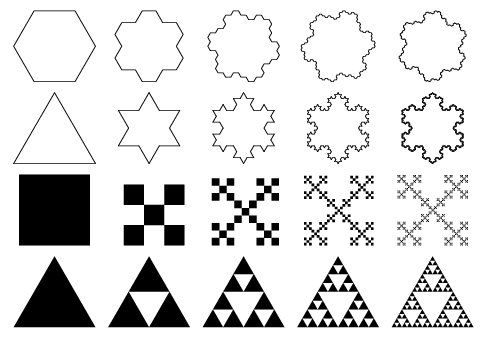
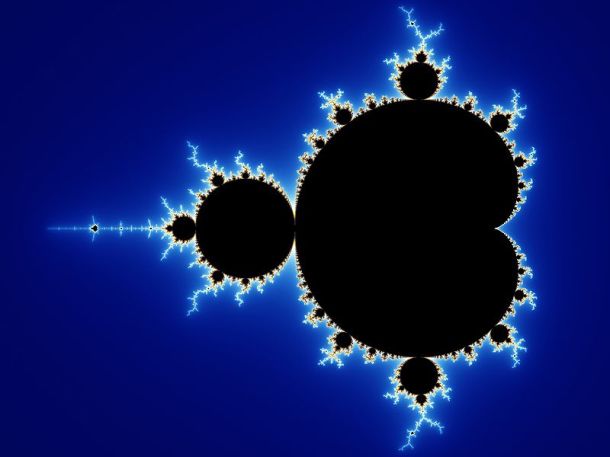
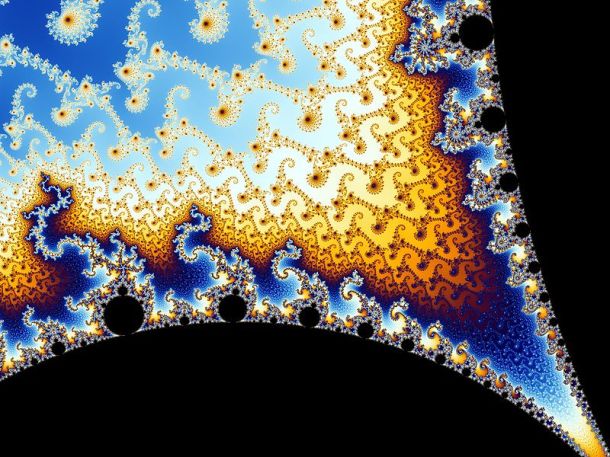

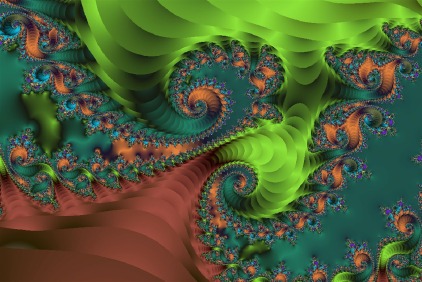

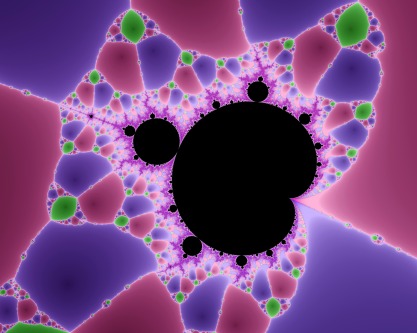
Great write-up! So Buzz Llightyear wasn’t such a fool after all… “To infinity, and beyond!”.
Buzz was a savant.
It’s all blowin’ ma minnnndddd….. imagine fractals in 4 or 5 dimensions!
Can’t even do it! 🙂
Thanks for posting, I enjoyed reading about that.
Great stuff! I love thinking about George Cantor’s transfinites, that some “infinities” are bigger than others. I first read about it in The Math Book by Clifford A. Pickover–I highly recommend it!
It’s a pretty crazy concept – sometimes these things just make me laugh, considering they’re intellectually logical, but practically absurd :). Thanks for the book recommendation, I’ll check it out!